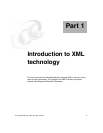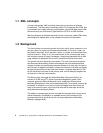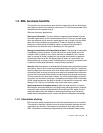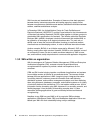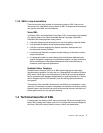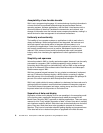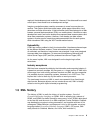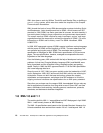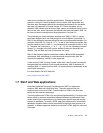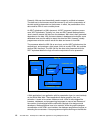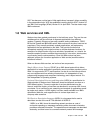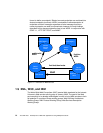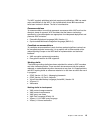Chapter 1. XML overview 9
required, the development cost would rise. However, if the data could be re-used
or built upon, there would be a re-development savings.
Imagine a navigation system used by consumers to move from one place to
another. This system would have street maps, yellow pages information, local
attractions and other information. If this information has to be displayed on a Web
browser, personal device assistant (PDA) or a mobile phone, it would be a major
development costs if we had to develop three separate data access systems and
three data presentation systems. However, if we develop one data access
systems, we also need to create three data presentation files for each system,
which transforms XML using the XSLT transformation feature.
Extensibility
HTML has a major problem in that it is not extensible. It has been enhanced upon
by the different software vendors. These enhancements have not been
co-ordinated, and therefore, have become non-standard. It was never designed
to access data from databases. To overcome this deficiency, Microsoft built
Active Server Pages (ASP) and Sun produced Java Server Pages (JSP).
As the name implies, XML was designed from the beginning to allow
extensions.
Industry acceptance
XML has been accepted by widely by the information and computing Industry. It
is based on common concepts. As time goes on, a large number of XML tools
will emerge from both existing software vendors and XML startup companies.
It is readable by every operating systems, because it is in ASCII text. This
implies that it can be seen by any text editor or word processor.
The tree-based structure of XML is much more powerful than fixed-length
data formats. Because objects are tree structures as well, XML is ideally
suited to working with object-oriented programming.
1.5 XML history
The history of XML is really the history of another system: Standard
Generalized Markup Language
or SGML. XML is actually just a subset of
SGML, and SGML has been around for many years. In fact, SGML dates back
to the late 60s and the work of an IBM employee Charles Goldfarb. Goldfarb
was developing a system to share documents, and together with two of his
colleagues, Edward Mosher and Raymond Lorie, he put together a markup
language called
Generalized Markup Language (GML). (Of course, GML
really stands for Goldfarb, Mosher, and Lorie, who invented it.)



